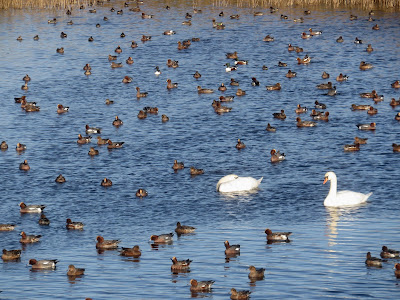Earlier 26 greylag geese were seen feeding in the park's grazing fields on the Wednesday, while the previous day 200 brent geese were seen in the fields.
A common seal swam close to the East Mersea Point as it headed up-river on a dull Monday 26th.
A female common scoter flew out of the river and there was a possible female scaup seen landing in the outer part of the river but a bit distant.
At the park pond 20 shoveler and 18 gadwall were the main ducks of note while a flock of 25 fieldfares flew to the north of the park, also 2 redwings, 15+ blackbirds.
At the park pond a common buzzard perched in the gloom in the trees above the water which worried the wildfowl below including the 22 shoveler and 18 gadwall. A flock of 25 fieldfares flew to the north of the park, also 2 redwings and 15+ blackbirds were seen at the park on Monday.
At West Mersea the black brant was seen near the Hard by Martin Cock on Monday.
On Sunday 25th a flock of 100 fieldfares flew south-west over the car park along with a couple of redwings. A big flock of 350+ fieldfares was seen by Martin also on Sunday, feeding in fields between Bromans Lane and Shop Lane. In the Pyefleet Channel on Sunday 6 red-breasted mergansers and a snipe were reported by Martin.
A barn owl flew over the East Mersea road at Bocking Hall early Sunday evening while earlier in the day 5 red-legged partridge were near Chapmans Lane.
Two rock pipits and 3 sanderling were at East Mersea Point on Saturday 24th
The snow bunting was last seen on the beach at East Mersea Point on Friday 23rd, its fifth day here and still very confiding on each day.
Four red-breasted mergansers and a common seal were in the Colne, a rock pipit at the Point, 40 curlews in the grazing fields while 5 goldcrests and a sparrowhawk were noted around the park.
A red squirrel was seen crossing East Mersea road near Church Lane early on Friday morning also two red squirrels together in the Firs Chase garden on Friday.
Lots of December moths dropped into the moth trap at the park during the night of Thursday 22nd, with 15 individuals noted which is the most ever seen here in one night. Most of the moths seemed in fresh condition and freshly emerged.
































